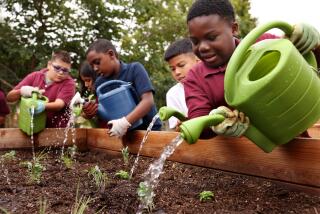Airing the Environment at an Urban School
- Share via
Poised in front of a microphone, Crenshaw High School Senior Veronica Pena read softly from a paper trembling in her hands.
“For 17 years,” she said, “I was lost in the city and thought the best thing in the world was to live a comfortable life where animals and vegetation were nowhere to be found.
“It took me 17 years to realize I was wrong and that, in fact, the best things in life are not getting a new outfit every two weeks, but rather being able to discover the beauty of nature.
“You wonder, how did this happen? Well, let me tell you about the place that changed my life.”
From there, as 30 Advanced Placement classmates at Crenshaw listened, Pena told the story of her transformation during a summer trip to Yellowstone National Park. At the same time, a tape was rolling, recording her words for a segment on National Public Radio’s “Living on Earth” program.
Sponsored by the Antioch New England Institute in New Hampshire, the “ecological literacy” program is offered in just five schools in the country. Students produce commentaries and reports of several minutes, some of which will be selected for use on the weekly environmental radio show next year. Interviews and tapings for the show, which attracts more than 1.2 million listeners, are done in class.
The school program was designed to teach environmental journalism to students in inner-city schools, said Carly Ferguson, director of operations for “Living on Earth” in Cambridge, Mass.
Pena, 18, is a good example of the students it attracts. An immigrant from El Salvador, she has always lived in big cities. Her trip to Yellowstone was her first exposure to bison, bears and geysers.
The environmental program is funded by grants from the National Science Foundation and by donations. Students are encouraged to think about their surroundings--everything from a trip to the mountains to living in South-Central Los Angeles--while honing writing, interviewing and technical skills.
“We really want kids to see that environment extends beyond trees,” Ferguson said. “A lot [of the commentaries] talk about living with gangs, and the ways they have to ease themselves out of their everyday lives.”
Teachers and mentors in the program have a chance to learn, too. Twice a year, they meet for a crash course in journalism. While many teachers have backgrounds in environmental studies and science, some lack reporting and technical skills.
The seminars teach basics such as how to ask questions and write reports for the radio, as well as how to use recording and production equipment. Ferguson said there are plans in the works to assign on-site producers with backgrounds in media to work with students.
Teaching environmental journalism to high school students is challenging because of the scope of specific skills and subjects involved, said Len Ackland, a professor of journalism and director of the Center for Environmental Journalism at the University of Colorado in Boulder. “I just hope [the program] emphasizes good journalism first, rather than the environment first,” he said. “There’s a difference between activists and journalists.”
Crenshaw teacher Tammy Bird-Beasley said that while the journalism skills are important, the most important aspect of the program is becoming involved in community issues and making sure “their voices are being heard.”
In Bird-Beasley’s class this year, students have interviewed an ex-gang member, as well as the new Crenshaw High principal. Last year, students interviewed officials from an energy company about a proposal to build a 52-megawatt power plant in Baldwin Hills, in the middle of a state park. Armed with tape recorders and microphones, students rode the bus to a public hearing and “got in the faces” of some officials, Bird-Beasley said.
She told them, “You’re a reporter, so go act like a reporter.”
In June, the energy company decided to abandon the project. Students’ segments did not air because the program was not fully launched at the time. But it gave them an opportunity to get involved in an important community issue, Bird-Beasley said.
Living in Los Angeles can be chaotic, said Bird-Beasley. “There is traffic, noise, more asphalt than grass in some places,” she said. “It’s the inner city--people are living on top of each other. You constantly hear helicopters and sirens.”
When students are asked to examine their surroundings, they often write about the special places where they feel relaxed and secure.
“In my room, the incense smoke spreads itself against the walls,” read senior Alec Coleman, 17, who spoke nervously into the microphone on a recent morning. “The lights are dim, with Lauren Hill playing on the radio in the background. The TV is off, without the common distraction or disturbing conflicts of the world. Finally, my day is at peace.”
When Coleman was finished, Lawren Atkins, 27, a mentor for the program, offered this advice: “You just gotta relax. Don’t think about other people while you’re reading. Don’t let anything distract you.”
“Living on Earth” producers want to make student reports a regular feature. Organizers are also in the process of expanding the environmental journalism program into more schools.
Student Kiana Hamblet, 17, said it is important for Crenshaw High students’ stories to be told, and she hopes they air nationwide.
“You hear more about gangs and people being killed daily than you hear about people going out and [growing] a plant,” she said.
for CLASS #1
More to Read
Sign up for Essential California
The most important California stories and recommendations in your inbox every morning.
You may occasionally receive promotional content from the Los Angeles Times.










